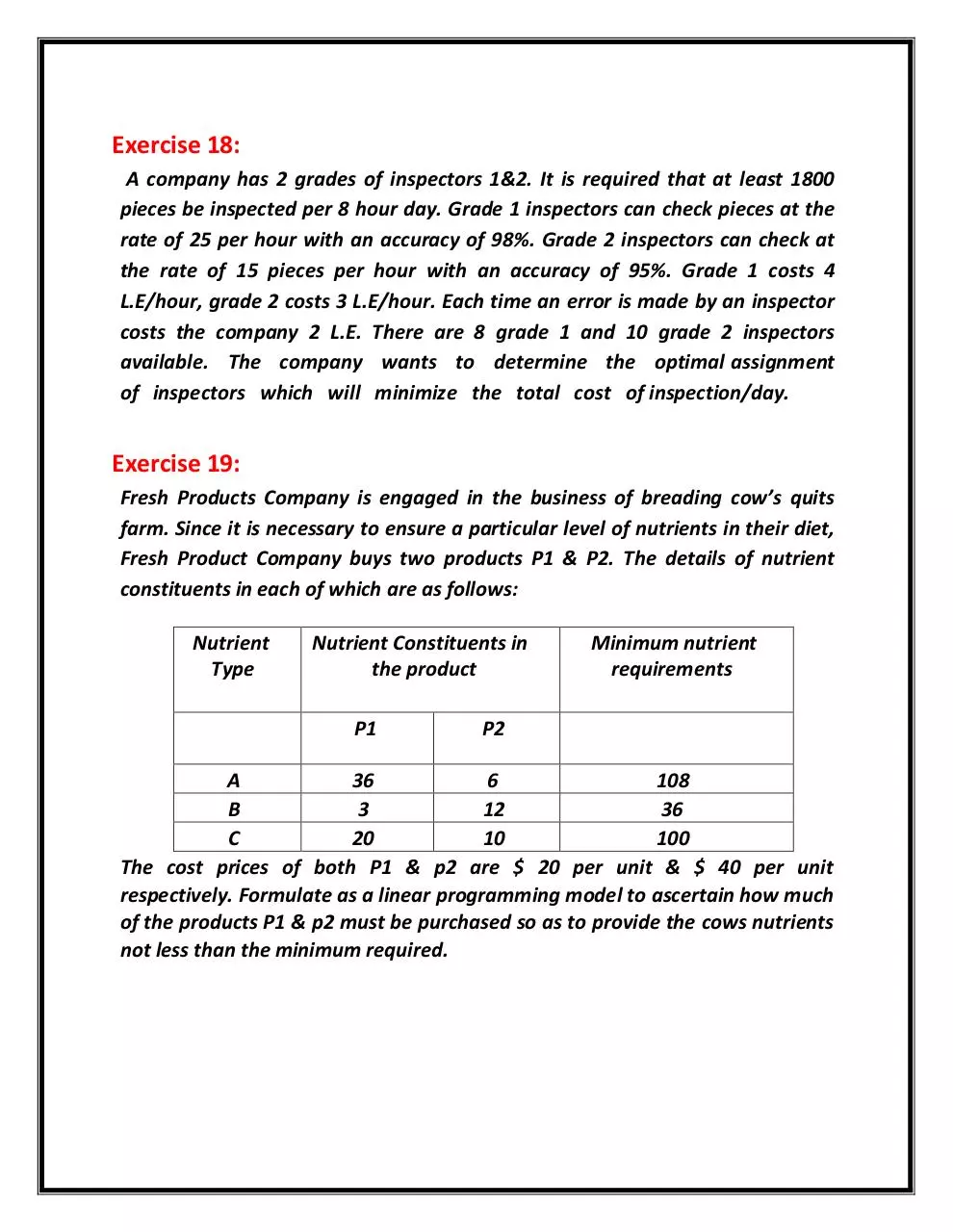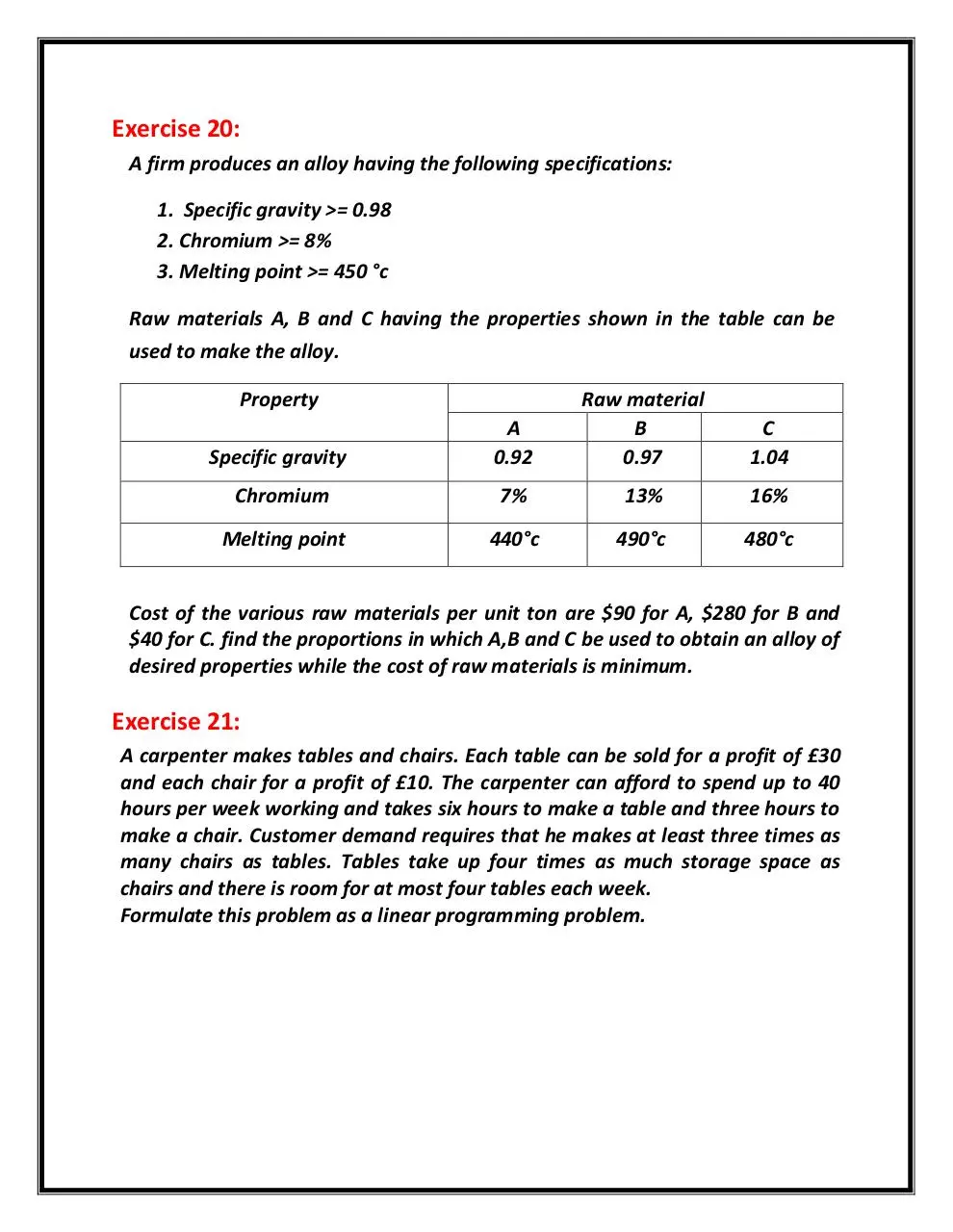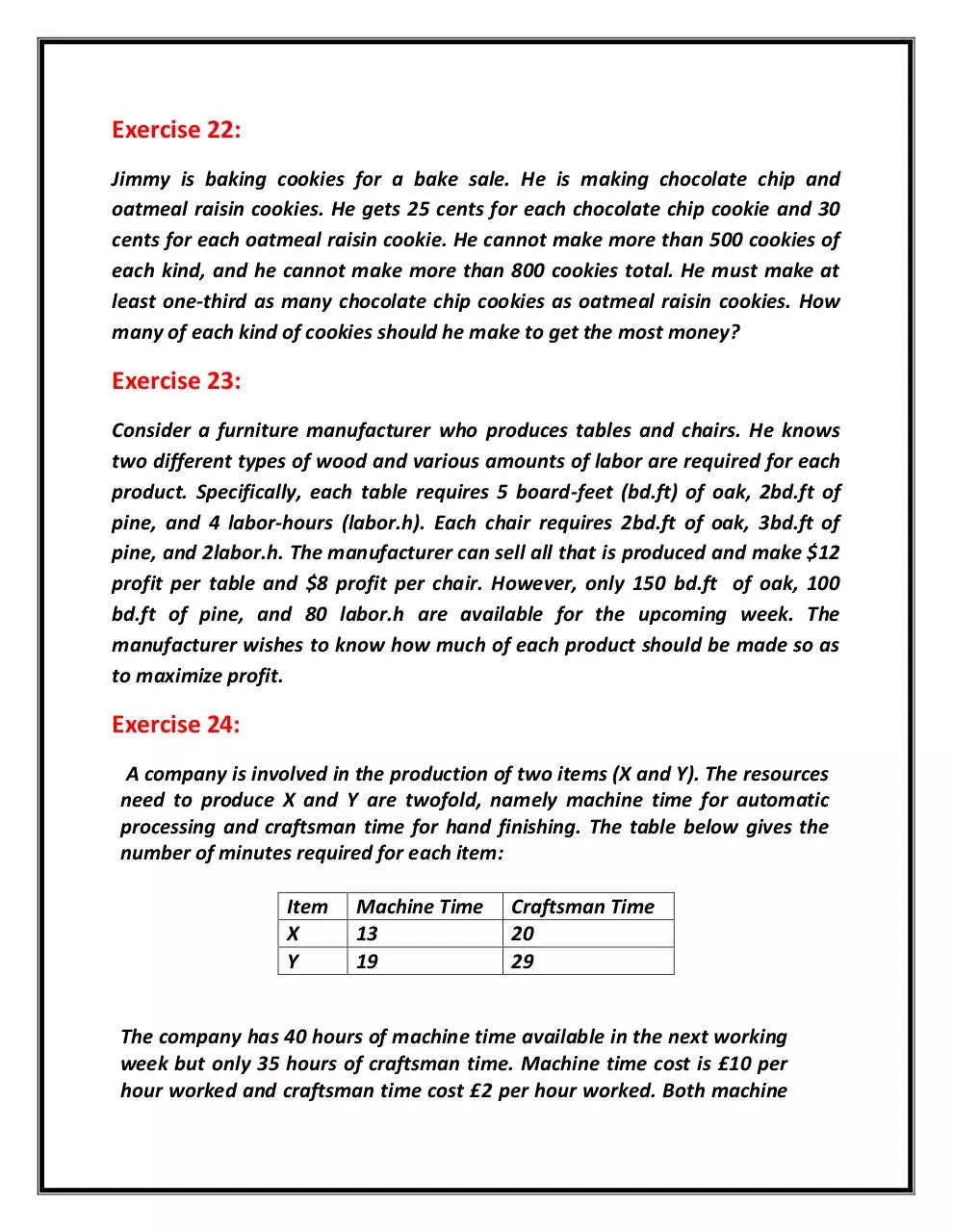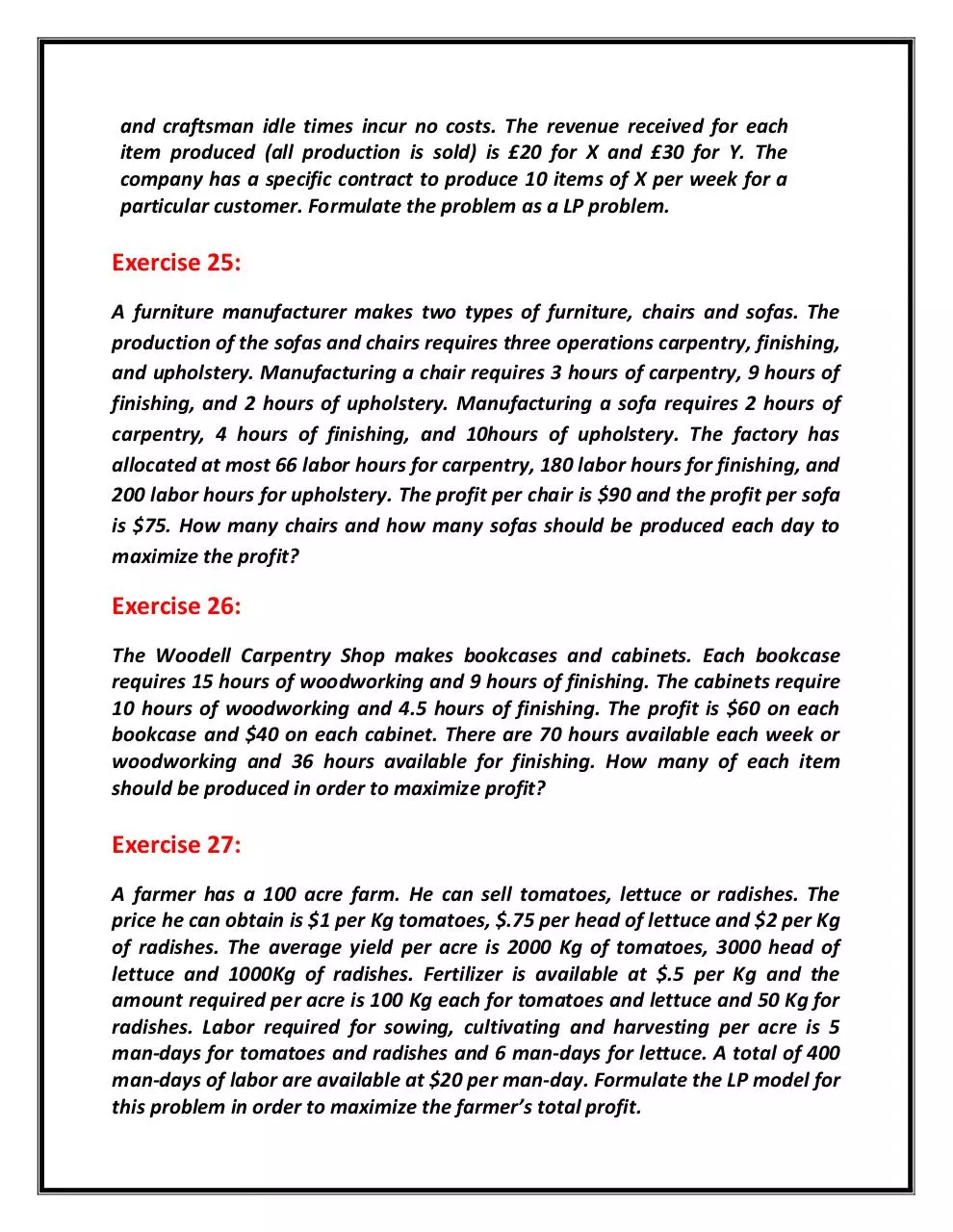2 (Modelling Sheet) (PDF)
File information
Author: Hagar
This PDF 1.5 document has been generated by Microsoft® Word 2010, and has been sent on pdf-archive.com on 05/11/2015 at 22:47, from IP address 41.176.x.x.
The current document download page has been viewed 632 times.
File size: 271.2 KB (4 pages).
Privacy: public file




File preview
Exercise 18:
A company has 2 grades of inspectors 1&2. It is required that at least 1800
pieces be inspected per 8 hour day. Grade 1 inspectors can check pieces at the
rate of 25 per hour with an accuracy of 98%. Grade 2 inspectors can check at
the rate of 15 pieces per hour with an accuracy of 95%. Grade 1 costs 4
L.E/hour, grade 2 costs 3 L.E/hour. Each time an error is made by an inspector
costs the company 2 L.E. There are 8 grade 1 and 10 grade 2 inspectors
available. The company wants to determine the optimal assignment
of inspectors which will minimize the total cost of inspection/day.
Exercise 19:
Fresh Products Company is engaged in the business of breading cow’s quits
farm. Since it is necessary to ensure a particular level of nutrients in their diet,
Fresh Product Company buys two products P1 & P2. The details of nutrient
constituents in each of which are as follows:
Nutrient
Type
Nutrient Constituents in
the product
P1
Minimum nutrient
requirements
P2
A
36
6
108
B
3
12
36
C
20
10
100
The cost prices of both P1 & p2 are $ 20 per unit & $ 40 per unit
respectively. Formulate as a linear programming model to ascertain how much
of the products P1 & p2 must be purchased so as to provide the cows nutrients
not less than the minimum required.
Exercise 20:
A firm produces an alloy having the following specifications:
1. Specific gravity >= 0.98
2. Chromium >= 8%
3. Melting point >= 450 °c
Raw materials A, B and C having the properties shown in the table can be
used to make the alloy.
Property
Specific gravity
A
0.92
Raw material
B
0.97
C
1.04
Chromium
7%
13%
16%
Melting point
440°c
490°c
480°c
Cost of the various raw materials per unit ton are $90 for A, $280 for B and
$40 for C. find the proportions in which A,B and C be used to obtain an alloy of
desired properties while the cost of raw materials is minimum.
Exercise 21:
A carpenter makes tables and chairs. Each table can be sold for a profit of £30
and each chair for a profit of £10. The carpenter can afford to spend up to 40
hours per week working and takes six hours to make a table and three hours to
make a chair. Customer demand requires that he makes at least three times as
many chairs as tables. Tables take up four times as much storage space as
chairs and there is room for at most four tables each week.
Formulate this problem as a linear programming problem.
Exercise 22:
Jimmy is baking cookies for a bake sale. He is making chocolate chip and
oatmeal raisin cookies. He gets 25 cents for each chocolate chip cookie and 30
cents for each oatmeal raisin cookie. He cannot make more than 500 cookies of
each kind, and he cannot make more than 800 cookies total. He must make at
least one-third as many chocolate chip cookies as oatmeal raisin cookies. How
many of each kind of cookies should he make to get the most money?
Exercise 23:
Consider a furniture manufacturer who produces tables and chairs. He knows
two different types of wood and various amounts of labor are required for each
product. Specifically, each table requires 5 board-feet (bd.ft) of oak, 2bd.ft of
pine, and 4 labor-hours (labor.h). Each chair requires 2bd.ft of oak, 3bd.ft of
pine, and 2labor.h. The manufacturer can sell all that is produced and make $12
profit per table and $8 profit per chair. However, only 150 bd.ft of oak, 100
bd.ft of pine, and 80 labor.h are available for the upcoming week. The
manufacturer wishes to know how much of each product should be made so as
to maximize profit.
Exercise 24:
A company is involved in the production of two items (X and Y). The resources
need to produce X and Y are twofold, namely machine time for automatic
processing and craftsman time for hand finishing. The table below gives the
number of minutes required for each item:
Item
X
Y
Machine Time
13
19
Craftsman Time
20
29
The company has 40 hours of machine time available in the next working
week but only 35 hours of craftsman time. Machine time cost is £10 per
hour worked and craftsman time cost £2 per hour worked. Both machine
and craftsman idle times incur no costs. The revenue received for each
item produced (all production is sold) is £20 for X and £30 for Y. The
company has a specific contract to produce 10 items of X per week for a
particular customer. Formulate the problem as a LP problem.
Exercise 25:
A furniture manufacturer makes two types of furniture, chairs and sofas. The
production of the sofas and chairs requires three operations carpentry, finishing,
and upholstery. Manufacturing a chair requires 3 hours of carpentry, 9 hours of
finishing, and 2 hours of upholstery. Manufacturing a sofa requires 2 hours of
carpentry, 4 hours of finishing, and 10hours of upholstery. The factory has
allocated at most 66 labor hours for carpentry, 180 labor hours for finishing, and
200 labor hours for upholstery. The profit per chair is $90 and the profit per sofa
is $75. How many chairs and how many sofas should be produced each day to
maximize the profit?
Exercise 26:
The Woodell Carpentry Shop makes bookcases and cabinets. Each bookcase
requires 15 hours of woodworking and 9 hours of finishing. The cabinets require
10 hours of woodworking and 4.5 hours of finishing. The profit is $60 on each
bookcase and $40 on each cabinet. There are 70 hours available each week or
woodworking and 36 hours available for finishing. How many of each item
should be produced in order to maximize profit?
Exercise 27:
A farmer has a 100 acre farm. He can sell tomatoes, lettuce or radishes. The
price he can obtain is $1 per Kg tomatoes, $.75 per head of lettuce and $2 per Kg
of radishes. The average yield per acre is 2000 Kg of tomatoes, 3000 head of
lettuce and 1000Kg of radishes. Fertilizer is available at $.5 per Kg and the
amount required per acre is 100 Kg each for tomatoes and lettuce and 50 Kg for
radishes. Labor required for sowing, cultivating and harvesting per acre is 5
man-days for tomatoes and radishes and 6 man-days for lettuce. A total of 400
man-days of labor are available at $20 per man-day. Formulate the LP model for
this problem in order to maximize the farmer’s total profit.
Download 2 (Modelling Sheet)
2 (Modelling Sheet).pdf (PDF, 271.2 KB)
Download PDF
Share this file on social networks
Link to this page
Permanent link
Use the permanent link to the download page to share your document on Facebook, Twitter, LinkedIn, or directly with a contact by e-Mail, Messenger, Whatsapp, Line..
Short link
Use the short link to share your document on Twitter or by text message (SMS)
HTML Code
Copy the following HTML code to share your document on a Website or Blog
QR Code to this page

This file has been shared publicly by a user of PDF Archive.
Document ID: 0000312996.